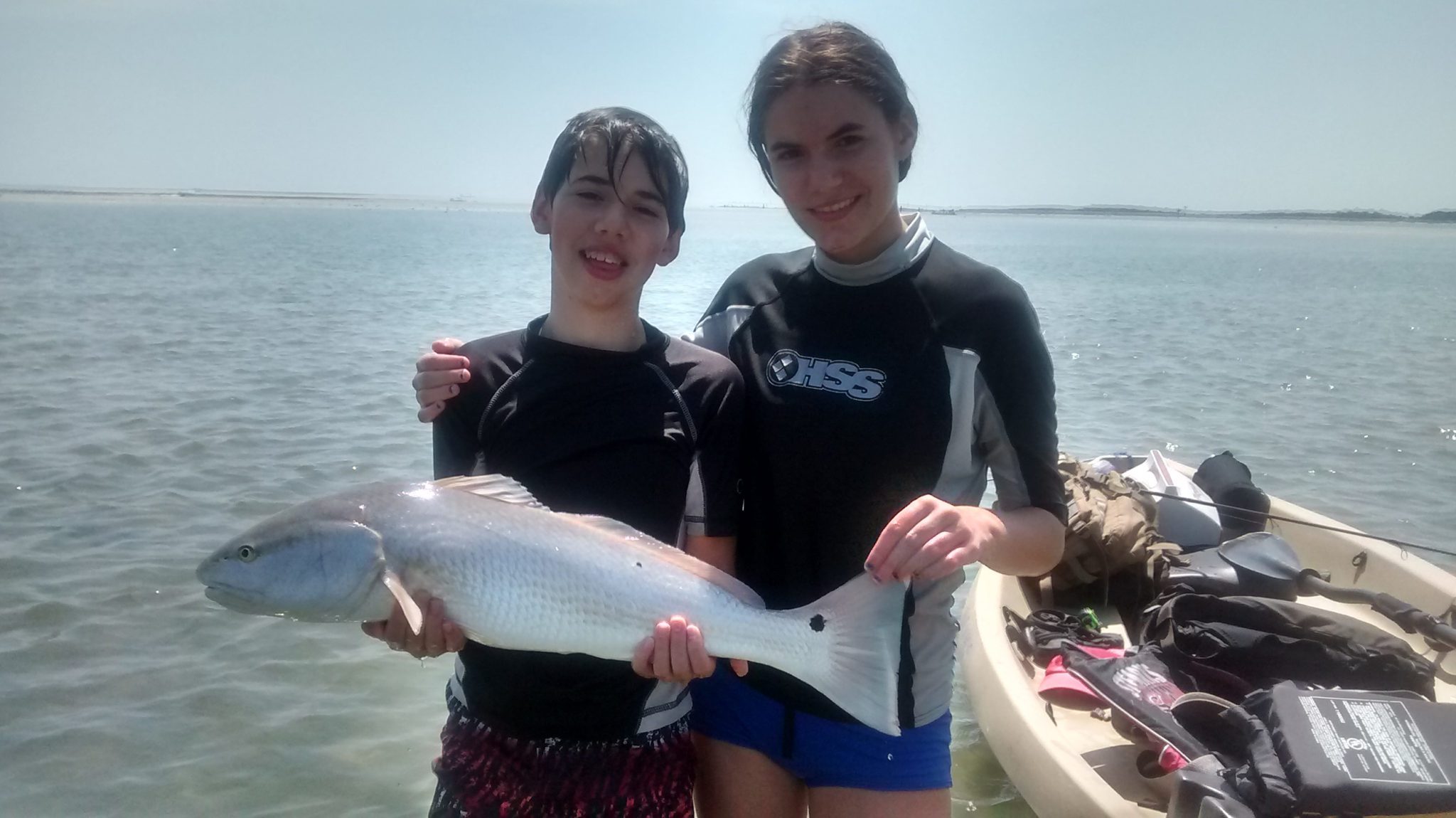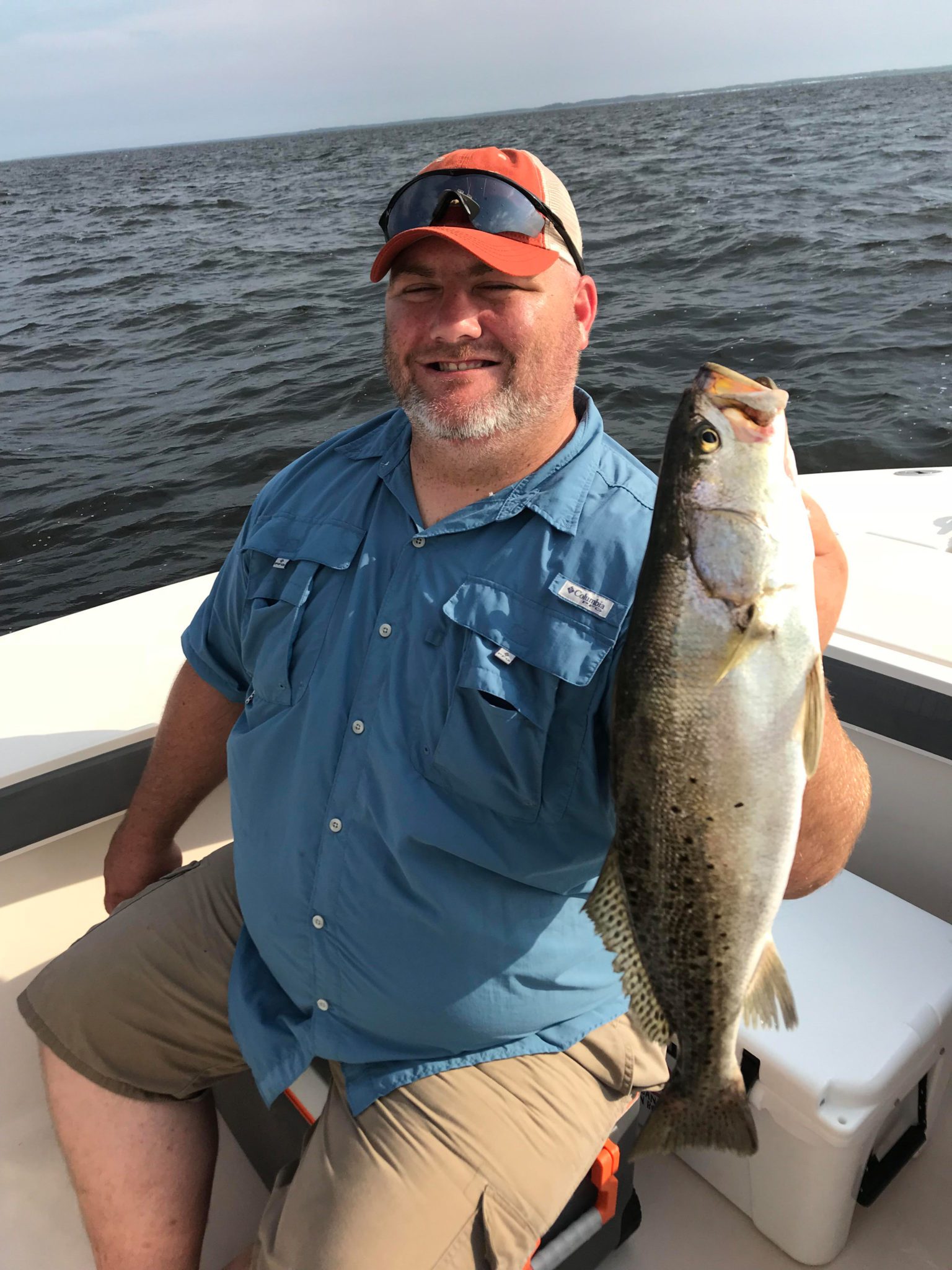Morehead – Aug 30, 2018
Matt, of Chasin’ Tails Outdoors, reports that old drum fishing on the Neuse River has been decent over the last week, though overall the bite has been up and down. The big reds have been everywhere from the New Bern Bridge down to Cedar Island. During the day, go with DOA Airhead lures and Z-Man 6” SwimmerZ rigged under Blabbermouth corks. At night, fresh mullet has been the go-to bait.
Speckled trout fishing has been slow, but conditions are looking promising for the fall season. The key is going to be a northeast wind, and then using live shrimp or Z-Man plastics (like the new 4” jerk shad).
Plenty of sheepshead (averaging around 5 lbs.) are still heavy in the area, with sea urchins and fiddler crabs getting the nod. Docks, bridges, and the port area are the best places to look, and they can be found in anywhere from 3-30’ of water.
Flounder fishing has been solid around the railroad tracks, the Port area, and ICW docks. Drifting channels around the Middle Marsh area has also put fish in the boat. Fishing any type of structure for long enough will produce some fish, especially when using live mullet or mud minnows.
Surf fishing has been difficult over the last few weeks, but the action is about to improve with the incoming fall season. Currently, sea mullet are coming in on bait shrimp at night.
Flounder on the nearshore reefs have been hard to get to, but there are definitely fish on AR-315, 285, and 320, where 2 oz. bucktails tipped with 4” Gulp shrimp will do the trick.
Spanish fishing has been decent when the weather allows, especially just outside the inlets and around the Cape Lookout area. Bigger fish are swimming around AR-315 and 285, where using finger mullet or pulling Mac-a-Hoos with dead cigar minnows should draw a strike.
King fishing has been slow, but trolling to the east of Cape Lookout, around AR-315, and in the Shipping Channel is the best way to improve your chances. Blue Water Candy dead bait rigs are the go-to, as are Mac-a-Hoos rigged with cigar minnows.
In the Stream, wahoo are chewing steadily from the northeast corner of the Big Rock down to the Swansboro Hole. Ballyhoo are the preferred bait, and when trolling, don’t be surprised to find some dolphin and billfish in the mix as well.
On the bottom, grouper, sea bass, grunts, amberjacks, and silver snappers have all been happily biting squid wings, especially around the 14 Buoy out to the 90’ Drop.

Sam and Natasha Fleek, from Cary, NC, with a redfish they hooked on a Z-Man StreakZ in electric chicken combined with a 3/8 oz. rattling jig head. They were fishing on the sand flats behind Carrot Island, near Beaufort.
Paul, of Freeman’s Bait & Tackle, reports that red drum are starting to show again in the backwaters, as most of them had retreated to the surf during the recent influx of fresh water. Now that salinity has been rising, anglers should be able to find them in better numbers.
Trout are also starting to make an appearance, though no spectacular catches have been made yet.
There haven’t been many inshore flounder catches to speak of, but along the port wall, sheepshead fishing has been productive.
In the surf, there are still some lingering red drum, and anglers can take advantage of a good sea mullet bite. Other assorted bottom fish have been chewing in the suds as well.
The nearshore spanish action has picked up dramatically, and more bluefish are starting to be mixed in with them. Flounder fishing has been much more productive on the nearshore wrecks and reefs than it has been inshore. Bucktail/Gulp combos get the nod.
Offshore, wahoo and scattered mahi have made up the majority of the catch.
Chris, of Mount Maker Charters, reports that old drum fishing on the Neuse River has been productive when using popping corks, while slot-sized reds are coming in on live and cut bait. Flounder have also been plentiful, and they’re biting best on finger mullet.
Cape Lookout has been holding plenty of false albacore that can be caught by casting to them.
The second weekend of red snapper was productive, with most of the fish coming from depths of 85-125’ on the east side. Cut mackerel was serving as the best bait.
Dave, of Cape Lookout Charters, reports that bait is everywhere.
Inshore, the redfish bite has been strong, with topwater baits and big Johnson spoons producing some pretty fish, but cut shad and mullet are working a little bit better. The biggest reds have been found at the mouth of Adams Creek and the South River. Popping corks and fresh bait are getting the nod for these big fish.
Shrimp and shad are grabbing the attention of trout and flounder.
Bluefish and spanish are being caught off the beach and in the inlets at high tide. Trolling and casting spoons have been working well.

Timmy from Salisbury with a 3.5 lb. speckled trout that was caught in the Neuse River on a live Carolina-rigged live shrimp. He was fishing with Capt. Chris Kimrey, of Mount Maker Charters.
Justin, of Breakday Charters, reports that the Neuse River Basin has been producing trophy drum when using popping corks (such as the Blabbermouth) rigged with a 24” leader to a 1/4 or 1/2 oz. heavy wide gap jig head tipped with a Z-Man SwimmerZ or DOA Airhead. Look for areas where you can see bait either with the naked eye or on your sonar, and fish thoroughly before moving on. You can also focus on shoal drop-offs with cut mullet on the bottom to find fish.
Target marsh banks and docks in the sound, ICW, and creeks with shrimp, mullet, and peanut bunker live baits for both black and red drum. Artificial baits will work as well, but live has definitely been better, especially when rigged on an appropriately-weighted Carolina rig (or just tip a naked jig head).
Plenty of spanish and kings are swimming along the beaches. Trolling sinker and planer rigs with small spoons will fill the box, but casting jigs on light tackle makes for a better fight. Bigger mackerel will fall for bump-trolled live mullet and menhaden and slow-trolled dead bait (like cigar minnows). Nearshore reefs, inlets, and hard bottom areas are the best places to look.
Tom, of Dancin’ Outlaw, reports that fishing has been difficult, but a few wahoo and a handful of dolphin have come in from the Big Rock.
Luann, of Oceanana Pier, reports that some spots are moving through the area, though they have been small. Some impressive redfish have been pulled from the suds at night, and the reds haven’t been picky when it comes to bait. Flounder are being caught throughout the day.
Anglers focusing on the end of the pier are finding spanish and bluefish to be plentiful.
